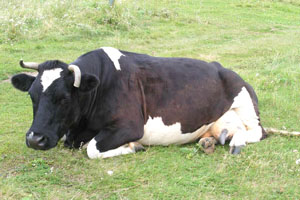Paratuberculosis in animals
Paratuberculosis of domestic animals is common in many countries of the world, as evidenced by numerous foreign literature data. According to the OIE, paratuberculosis has been registered in 61 countries of the world, including our country.
Paratuberculosis (paratuberculosis enteritis, Yone's disease) is an infectious chronic disease that leads to exhaustion and death of animals, characterized by diffuse thickening of the intestinal mucosa and submucosa with the formation of transverse and longitudinal folds, accompanied by a violation of the suction function .
The causative agent of paratuberculosis is Mycobacterium paratuberculosis. it is a thin, polymorphic, gram-positive, immobile rod 0.5-1.5 µm long and 0.2-0.5 µm wide, does not form spores, grows under aerobic conditions, is acid-alcohol resistant, stains well according to Ziehl-Nielsen in ruby red color. Cattle , sheep, goats, wild ruminants, deer are
susceptible to the pathogen; rabbits, hamsters and white mice are susceptible from laboratory animals with intravenous infection. Horses and pigs can be carriers.
The main source of the causative agent of paratuberculosis are clinically and latently sick animals that excrete a huge amount of mycobacteria with feces, abundantly infecting watering places, pastures, feed, bedding, premises and other environmental objects that are infection transmission factors.
Young animals under the age of 6 months are mainly infected through infected feed and water, as well as through udder teats contaminated with mycobacteria, when drinking contaminated MILK, interspecies transmission is also possible.
The incubation period of this disease lasts for months and even years. There are latent (hidden form) and open (clinical form) course of the disease.
There is no effective diagnostic tool for identifying latently sick animals yet. For lifetime diagnosis, bacterioscopic, allergic (avian tuberculin or paratuberculin is administered and, as in tuberculinization, the result of an allergic test is taken into account) and serological (RSK) methods.
Economic damage is determined by a decrease in the productivity of sick animals (MEAT, dairy, wool), forced slaughter of clinically ill animals, as well as significant costs associated with diagnostic studies and restrictive measures.
Since paratuberculosis is brought into farms with latently sick animals, special attention must be paid to the fact that the acquisition of herds and the delivery of livestock is carried out only from farms free of paratuberculosis. To prevent the disease, it is necessary to comply with zoohygienic requirements for keeping and feeding animals. It is necessary to conduct a thorough examination of the intestines after the slaughter of animals received at the meat processing plant , in order to timely detect diseases and take measures to limit unfavorable territories.
If paratuberculosis is diagnosed in the farm, restrictions are imposed on the farm. All clinically ill animals must be isolated in a timely manner and handed over for slaughter.
Carry out with mandatory rechecking an allergic test and RSK to identify latently sick animals. Milk is pasteurized or boiled, after which it is soldered to young animals. Manure is burned or subjected to biothermal disinfection for 2 years. In a dysfunctional economy, a thorough disinfection of the premises is carried out. Restrictions are removed from the farm, subject to the receipt of negative test results for avian tuberculin or negative tests in the RSK during the year.
The material was prepared by specialists from the Laboratory for the Diagnosis of ASF and Other Especially Dangerous Animal Diseases of the Rostov Reference Center of ROSSELKHOZNADZOR.
Source: Rostov Reference Center of Rosselkhoznadzor

